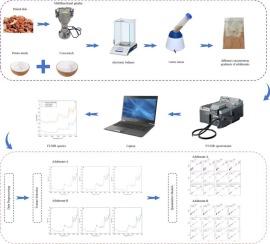基于FT-NIR和化学计量学的花生包衣粉中淀粉掺假物的定量分析
IF 3.4
3区 物理与天体物理
Q2 INSTRUMENTS & INSTRUMENTATION
引用次数: 0
摘要
花生皮以其高药用价值而闻名,但如果掺入淀粉类物质,其功效就会降低。提出了一种基于傅里叶变换近红外光谱(FT-NIR)技术的市面上掺假花生皮粉的高效检测方法。以马铃薯淀粉和玉米淀粉为常见掺假物质,制备了不同掺假水平的样品。然后,采用化学计量学方法建立了掺假物的定量分析模型。首先,对采集到的光谱数据进行预处理。随后,使用竞争自适应重加权采样(CARS)、Bootstrapping Soft Shrinkage (BOSS)和变量组合总体分析(VCPA)算法进行特征选择。最后,应用偏最小二乘回归(PLSR)、支持向量机(SVM)和随机森林(RF)模型定量分析了不同物质的掺假水平,并比较了它们的预测性能。实验结果表明,BOSS特征选择方法结合SVM模型对马铃薯淀粉掺假的预测准确率最高,RP2为0.9953。对于玉米淀粉掺假,使用支持向量机模型的全变量数据集获得了最高的准确率,RP2达到0.9957。这些发现表明,将FT-NIR技术与先进的机器学习技术相结合,可以高精度地识别和定量花生皮中的不同掺杂物,为食品质量监测提供了一种高效可靠的方法。本文章由计算机程序翻译,如有差异,请以英文原文为准。

Quantitative analysis of starch adulterants in peanut coating powder based on FT-NIR and chemometric methods
Peanut skin, known for their high medicinal value, can experience reduced efficacy when adulterated with starchy substances. This study presents an efficient detection method based on Fourier Transform Near-Infrared Spectroscopy (FT-NIR) technology for adulterated peanut skin powder found in the market. Potato starch and corn starch were selected as common adulterants, and a range of samples with different adulteration levels was prepared. Then, Chemometric methods were employed to build quantitative analysis models for the adulterants. First, the collected spectral data were preprocessed. Subsequently, feature selection was conducted using Competitive Adaptive Reweighted Sampling (CARS), Bootstrapping Soft Shrinkage (BOSS), and Variable Combination Population Analysis (VCPA) algorithms. Finally, Partial Least Squares Regression (PLSR), Support Vector Machine (SVM), and Random Forest (RF) models were applied to quantitatively analyze the adulteration levels of different substances, and their predictive performances were compared. Experimental results revealed that the BOSS feature selection method combined with the SVM model yielded the highest prediction accuracy for potato starch adulteration, achieving an of 0.9953. For corn starch adulteration, the highest accuracy was achieved using the full-variable dataset with the SVM model, reaching an of 0.9957. These findings demonstrate that integrating FT-NIR technology with advanced machine learning techniques enables high-precision identification and quantification of different adulterants in peanut skins, providing an efficient and reliable approach for food quality monitoring.
求助全文
通过发布文献求助,成功后即可免费获取论文全文。
去求助
来源期刊
CiteScore
5.70
自引率
12.10%
发文量
400
审稿时长
67 days
期刊介绍:
The Journal covers the entire field of infrared physics and technology: theory, experiment, application, devices and instrumentation. Infrared'' is defined as covering the near, mid and far infrared (terahertz) regions from 0.75um (750nm) to 1mm (300GHz.) Submissions in the 300GHz to 100GHz region may be accepted at the editors discretion if their content is relevant to shorter wavelengths. Submissions must be primarily concerned with and directly relevant to this spectral region.
Its core topics can be summarized as the generation, propagation and detection, of infrared radiation; the associated optics, materials and devices; and its use in all fields of science, industry, engineering and medicine.
Infrared techniques occur in many different fields, notably spectroscopy and interferometry; material characterization and processing; atmospheric physics, astronomy and space research. Scientific aspects include lasers, quantum optics, quantum electronics, image processing and semiconductor physics. Some important applications are medical diagnostics and treatment, industrial inspection and environmental monitoring.

 求助内容:
求助内容: 应助结果提醒方式:
应助结果提醒方式:


